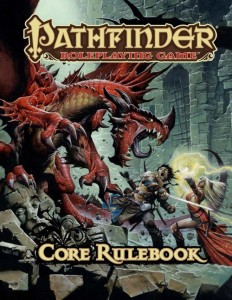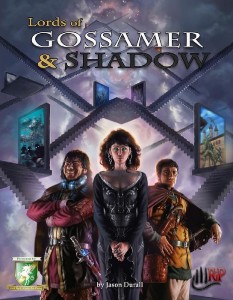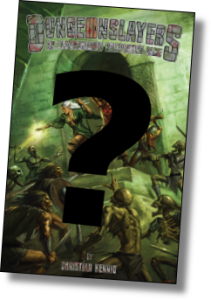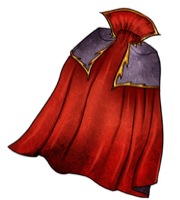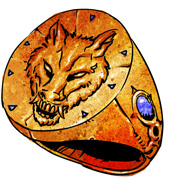Last week I ran a boring game! I fully understood what I was doing and I ran with it. I wanted the game to be boring. I wanted the players to look at me and for me to shrug as the game was their responsibility at this point. I planned it, I ran it, and it worked very well. Today’s post is in a way about why I did this to my players, and on a larger scale, a follow on from last weeks post about violence in games where I said I would write about other styles of conflict.
Now, the game I ran last week was not so fantasy based so let me relate to you the tale in fantasy speak. The players are members of a vessel that set out exploring trade in mysterious lands. Unfortunately the player that had taken up the sextant in the role of the navigator knew very little about where he was going and somehow managed to get their vessel afloat in the sea of darkness. With me so far? Good!
The players aboard the vessel soon learnt they were not alone in the sea of darkness. They found another interesting vessel seemingly built for a different race afloat on the sea. They boarded it and found nothing but unusual magical items and a tome written in a long dead language. They returned to their own vessel and began the process of deciphering it. As they did though another ship appeared on the sea of darkness and offered our lost heroes a way to free themselves from the sea if they would just follow them. They did and found a big vessel long thought lost to the ravages of time.
Right, now we are done fantasying up the Traveller game I ran (sneaking it under Jeffrey’s nose as fantasy is a job I enjoy!) [Editor’s Note: Not so sneaky! I pre-read all posts! ~Jeffrey] let us talk about why I made the game a boring one. Players are largely used to working out things with the help of large neon signs that we as GM’s load up the game with. If we want to get you to rescue a princeling or something similar, he will likely appear in a couple of games and then be stolen in the dark of night once someone takes a liking to them. Or they will find a scrap of one of the players clothing left at the scene of the crime and you will have to rescue the blighter just to clear your name. In his room you will find a bone wand inimical of the orcish clans just north of the city. You get there and find out it was stolen but one of the orcs caught sight of a member of the thieves guild stealing it. You head back to town and hit the thieves guild finding the princeling and uncovering a larger plot… continue campaign.
Sound familiar? We GM’s can be real stuck in our ways at times. Well in my exceptionally fantasy Traveller game I actually run a very open game and I have a completely open mind when it comes to running it. I don’t necessarily want massive amounts of conflict to run the game and I take the cues from my players as to what is actually happening in the game world. In the particular game I mentioned the players have put themselves in a pickle. I have allowed them the chance to get themselves out of it but they need to drive this. So what did I do? I put the players in a room (errr.. cold dungeon cell) under guard and allowed the game to run from there.
I did this because the vessel (yes I am fantasying it up again) was controlled by two things. First thing that the players would realise is that they were being held by a spirit (best analogy for an AI I could come up with) and it’s henchmen undead (read robots) for guards. They were by no means inhospitable and all requests were met with excellent focus though they were not allowed out. So the players sat in the cell and discussed their options. They seemed to be talking with other real life people but they knew there was something shifty going on. They discussed this at length with themselves and kept coming up with plans to be let out of the room. After all, they had been promised a way out when they came here. In all honesty, the game lasted a good two and a half hours with the players trapped in this room. There was much conjecture and trialling going on by the players and eventually they cracked the “spirit” and made an interesting discovery.
They were not alone. In fact there were other humanoids also in lockdown that were being kept alive and there was also a new race on the scene, a GM special as we GM’s arrogantly like to call them. They were a race borne of humans and they were the only living thing the spirit allowed free roaming on the vessel. OK, if you want to know how our hale adventurers (read space explorers) handled themselves, nip over to my blog (the awesome Pathfinder Chronicles and look up the blog that mentions the errr… pre-eminent fantasy writer Asimov?) As for the rest of this blog I will explain why I designed the game this way and show you why it was the best boring game I have run in a long time.
This game was all about conflict, but not the kind that involves eruptions of blood from arteries in high action sequences. This was four characters in a room with no idea what was going on who had to make sense of their situation. It plays on the amnesia trope in a way where the player wakes up and has no idea what is going on. In this situation though the tension was drawing on the fact that they knew everything that their character knew up until walking into the room, but had no clue what was going on aboard the vessel! The conflicts in this game came from social conflict (as they had communication remotely to the spirit and its incarnations) between themselves at times as well as the unknown environment. The other thing that this setting brewed up was the imagination of the players. I can not tell you how many hairbrained situations that they came up with while trying to work out what was going on!
The players really enjoyed this game I think. Right at the end they got to meet with the true villains of the piece (the Panold race) and have some interaction with them. They had a great game and not a single shot was fired (although they did mention it a lot!). There are some secrets in making this style of game come off well.
- Know what is really happening before you play this style of game. It is really important as a GM that you go into this eyes wide open. If you wait for the players to come up with a great idea for you to run with you will overstay the excitement of the game and then they will say that you just did what they said.
- Play up to some of the PC’s propositions if the circumstances could seem to be exactly what they are saying
- Push through the silences. The players will look to you for a giant glowing neon sign. Do not give it to them. Just keep asking what they are doing or how their character is feeling. They have to become aware that the game relies on them to make the decisions.
- Have an exit point. You can’t leave the players in the room forever. Have them spot something in a vent (er.. small cave) that may show them another way out. Do not reward them with anything informative though. They still need to use this new information to find out what is going on (e.g. they feel a breeze coming through a crack, could there be a passage just beyond the door?) This gives them a way of getting out of the cell but they will still be surprised by the new race and the overall plot.
- Let them out when they are close enough to knowing something that they could succeed at a bluff with. Once they are that close, reward them. They are never going to guess that they have been captured by a race of highly intelligent mice but they might be able to get close and they should be rewarded!
So there you have it. Combat is fun as it risks a character’s mortal coil, but social or mystery encounters can offer new and varied experiences with the game that puts a focus right on the character. Consider your current game and think like Batman’s Riddler. How can you wrap the next clue to the puzzle in a box wrapped in a mystery and surrounded by an enigma that the players need to solve by role playing their characters. Once you have that in your head design it and you are guaranteed to make a memorable session for the players. Keep rolling!
Mark Knights is 39 year old guy living in a small rural town called Elliott in Tasmania, Australia. I have been role playing since I was 11 years old playing the original versions of Dungeons and Dragons, MERP, Elric, Dragon Warriors and the like amongst other genre games. I played D&D 2nd Edition through the 90′s but I ran Earthdawn for my fantasy setting and loved it as a GM. When 3rd Edition came out for D&D I tried it but found it too heavy on rules. I ignored the 3.5 edition of DnD in favour of Earthdawn (big mistake) as I thought it was just a money spinner. When 4th Edition DnD came on my players and I gave it a red hot go but hated what it had dumbed the game down to be. On a trip to Melbourne to buy some 4E stuff from a hobby store an old mate of mine pointed me at Pathfinder and in a Fantasy setting I have never looked back.



